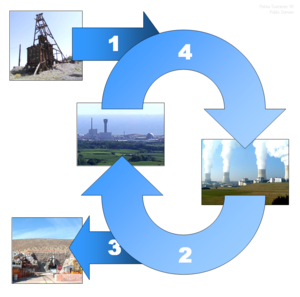
- Image via Wikipedia
A new report argues that the world has plenty of uranium but needs to make wise choices about what to do with it once its been depleted in a nuclear reactor
On September 15, the U.S. Nuclear Regulatory Commission affirmed its expert opinion that spent nuclear fuel could be safely stored on nuclear power plant grounds—whether in pools or dry casks—for “at least 60 years beyond the licensed life of any reactor.” That is good news, because there is nowhere else for such waste to go.
As President Obama’s Blue Ribbon Commission on America’s Nuclear Future continues to ponder what role nuclear power might play in the U.S. electricity supply, a group of scientists, engineers and other experts assembled by the Massachusetts Institute of Technology (M.I.T.) released a report on the nuclear fuel cycle paid for by the nuclear industry. In short, the report finds that uranium resources are not likely to run out in the next century, even if the U.S. alone builds as many as 1,000 nuclear reactors. Therefore, either reprocessing or recycling spent nuclear fuel, as the French and Japanese do, is likely to be a waste of money better spent on improving the light-water reactors presently in use. The funds could also be used to create a $670-million-per-year research and development program for nuclear power as well as to determine the best fuel cycle over the course of the next several decades. Finally, the global expansion of nuclear power plants should be enabled by some form of leasing program for the uranium fuel rods—one up for renewal every decade or so.
“For the next several decades in the U.S. the once-through fuel cycle using light-water reactors is the preferred option,” said M.I.T. physicist and report co-chair Ernest Moniz at its release on September 16 in Washington, D.C. “Light-water reactors are the workhorse, and there’s a lot we can do to improve [them].” The U.S. employs 104 light-water reactors to generate 20 percent of its electricity today; the reactors moderate uranium fission and the heat it produces with water, which is also boiled into steam to turn an electricity-generating turbine.
M.I.T. nuclear engineer Charles Forsberg, another co-chair of the report, noted that a typical light-water reactor in the U.S. needs 200 metric tons of mined uranium resulting in 20 metric tons of uranium fuel per year. All this uranium represents as little as 2 percent of the final cost of the electricity from that nuclear power plant. Therefore, even if uranium prices doubled or more, the impact on electricity prices would be minimal.
The M.I.T. report predicts that even if the world’s fleet of more than 400 nuclear power plants grew to be 4,000 such plants that then operated for a century, the cost of the electricity from those facilities would rise by a mere 1 percent as a result of the increased demand for uranium. “There’s no shortage of uranium that might constrain future commitments to build new nuclear plants for much of the century,” Forsberg said. This also argues against alternate fissile fuels such as thorium. “What do you get by complicating the fuel cycle by looking at thorium when we have plenty of uranium?” asked M.I.T. nuclear engineer and report co-chair Mujid Kazimi.
The question then becomes what to do with that abundant uranium once it’s been fissioned in a nuclear reactor. After all, the spent nuclear fuel still contains fissionable uranium 235 and plutonium 239. “Today, we don’t know whether spent nuclear fuel from light-water reactors is waste or a resource,” Moniz noted. Forsberg added that the spent nuclear fuel currently awaiting a home in the U.S. could be compared with “a super-strategic petroleum reserve. We should be cautious before we throw it away.”
The Latest Streaming News: Spent Nuclear Fuel updated minute-by-minute








